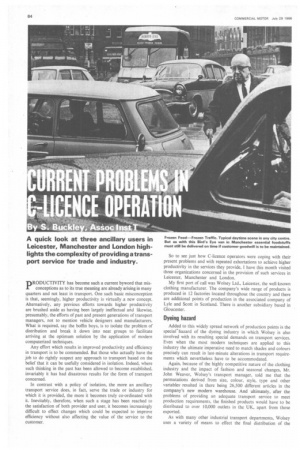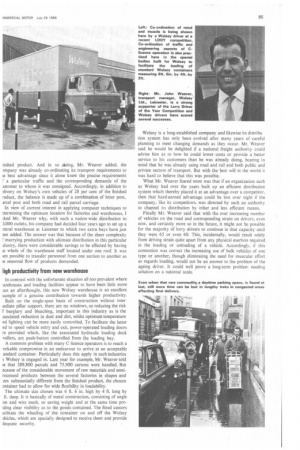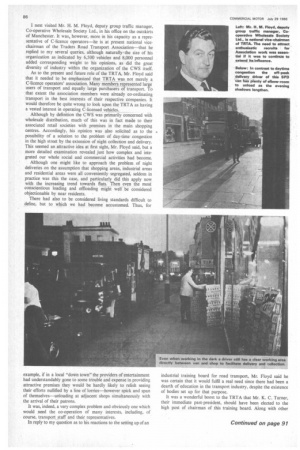p RODUCTIVITY has become such a current byword that misconceptions as
Page 86

Page 87

Page 88

If you've noticed an error in this article please click here to report it so we can fix it.
to its true meaning are already arising in many quarters and not least in transport. One such basic misconception is that, seemingly, higher productivity is virtually .a new concept. Alternatively, any previous efforts towards higher productivity are brushed aside as having been largely ineffectual arid likewise, presumably, the efforts of past and present generations of transport managers. not to mention vehicle designers and manufacturers. What is required, say the boffin boys, is to isolate the problem of distribution and break it down into neat groups to facilitate arriving at the optimum solution by the application of modern computerized techniques.
Any effort which results in improved productivity and efficiency in transport is to be commended. But those who actually have the job to do rightly suspect any approach to transport based on the belief that it can be usefully considered in isolation. Indeed, where such thinking in the past has been allowed to become established, invariably it has had disastrous results for the form of transport concerned.
In contrast with a policy of isolation, the more an ancillary transport service does, in fact, serve the trade or industry for which it is provided, the more it becomes truly co-ordinated with it. Inevitably, therefore, when such a stage has been reached to the satisfaction of both provider and user, it becomes increasingly difficult to effect changes which could be expected to improve efficiency without also affecting the value of the service to the customer. So to see just how C-licence operators were coping with their present problems and with repeated exhortations to achieve higher productivity in the services they provide. I have this month visited three organizations concerned in the provision of such services in Leicester, Manchester and London.
My first port of call was Wolsey Ltd., Leicester, the well-known clothing manufacturer. The company's wide range of products is produced in 12 factories located throughout the country and there are additional points of production in the associated company of Lyle and Scott in Scotland. There is another subsidiary based in Gloucester.
Dyeing hazard
Added to this widely spread network of production points is the special' hazard of the dyeing industry in which Wolsey is also involved with its resulting special demands on transport services. Even when the most modern techniques are applied to this industry the ultimate imperative need to match shades and colours precisely can result in last-minute alterations in transport requirements which nevertheless have to be accommodated.
Again, because of the highly competitive nature of the clothing industry and the impact of fashion and seasonal changes, Mr. John Weaver, Wolsey's transport manager, told me that the permutations derived from size, colour, style. type and other variables resulted in there being 26,500 different articles in the company's new modern warehouse. And ultimately, after the problems of providing an adequate transport service to meet production requirements. the finished products would have to be distributed to over 10,000 outlets in the UK, apart from those exported.
As with many other industrial transport departments, Wolsey uses a variety of means to effect the final distribution of the
aished product. And in so Acing, Mr. Weaver added, the nnpany was already co-ordinating its transport requirements to te best advantage since it alone knew the precise requirements F. a particular traffic and the corresponding demands of the Jstomer to whom it was consigned. Accordingly, in addition to :livery on Wolsey's own vehicles of 28 per cent of the finished roduct, the balance is made up of a combination of letter post, areel post and both road and rail parcel carriage.
In view of current interest in applying computer techniques to hermining the optimum location for factories and warehouses, I ;ked Mr. Weaver why, with such a nation-wide distribution to ),000 outlets, his company had decided four years ago to set up a :ntral warehouse at Leicester to which two extra bays have just xn added. The answer was that because of the sheer complexity r marrying production with ultimate distribution in this particular klustry, there were considerable savings to be effected by having ie whole of the warehouse staff located under one roof. It was ten possible to transfer personnel from one section to another as le seasonal flow of products demanded.
figh productivity from new warehouse In contrast with the unfortunate situation all too prevalent where 'arehouses and loading facilities appear to have been little more an an afterthought, this new Wolsey warehouse is an excellent Kample of a genuine contribution towards higher productivity. Built on the single-span basis of construction without intertediate pillar support, there are no windows, so reducing the risk f burglary and bleaching, important in this industry as is the 3sociated reduction in dust and dirt, whilst Optimum temperature ad lighting can be more easily controlled. To facilitate the latter rid to speed vehicle entry and exit, power-operated loading doors re provided which, like the associated hydraulic loading dock yellers, are push-button controlled from the loading bay.
A common problem with many C-licence operators is to reach a 'orkable compromise in an endeavour to arrive at an acceptable .andard container. Particularly does this apply in such industries 3 Wolsey is engaged in. Last year for example, Mr. Weaver told te that 389,800 parcels and 75.900 cartons were handled. But ecause of the considerable movement of raw materials and semirocessed products between the several factories in shapes and zes substantially different from the finished product, the chosen antainer had to allow for wide flexibility in loadability.
The ultimate size chosen was 6 ft. 6 in. high by 4 ft. long by ft. deep. It is basically of metal construction, consisting of angle on and wire mesh, so saving weight and at the same time pro[ding clear visibility as to the goods contained. The fitted castors icilitate the wheeling of the container on and off the Wolsey .:hicles, which are specially designed to receive them and provide ['equate security_
Wolsey is a long-established company and likewise its distribu tion system has only been evolved after many years of careful planning to meet changing demands as they occur. Mr. Weaver said he would be delighted if a national freight authority could advise him as to how he could lowercosts or provide a better service to his customers than he was already doing, bearing in mind that he was already using road and rail and both public and private sectors of transport. But with the best will in the world it was hard to believe that this was possible.
What Mr. Weaver feared most was that if an organization such as Wolsey had over the years built up an efficient distribution system which thereby placed it at an advantage over a competitor, then that hard-earned advantage could be lost over night if the company, like its competitors, was directed by such an authority to channel its distribution by other and less efficient means.
Finally Mr. Weaver said that with the ever increasing number of vehicles on the road and corresponding strain on drivers, even now, and certainly more so in the future, it might not be possible for the majority of lorry drivers to continue in that capacity until they were 65 or even 60. This, incidentally, would result solely from driving strain quite apart from any physical exertion required in the loading or unloading of a vehicle. Accordingly, if this contention was correct the increasing use of bulk vehicles of one type or .another, though eliminating the need for muscular effort as regards loading, would not be an answer to the problem of the ageing driver. It could well prove a long-term problem needing solution on a national scale. I next visited Mr. H. M. Floyd, deputy group traffic manager, Co-operative Wholesale Society Ltd., in his office on the outskirts of Manchester. It was however, more in his capacity as a representative of C-licence operators—he is at present national vicechairman of the Traders Road Transport Association—that he replied to my several queries, although naturallrthe size of his organization as indicated by 6,500 vehicles and 8,000 personnel added corresponding weight to his opinions, as did the great diversity of industry within the organization of the CWS itself.
As to the present and future role of the TRTA, Mr. Floyd said that it needed to be emphasized that TRTA was not merely a C-licence operators' association. Many members represented large users of transport and equally large purchasers of transport. To that extent the association members were already co-ordinating transport in the best interests of their respective companies. It would therefore be quite wrong to look upon the TRTA as having a vested interest in operating C-licensed vehicles.
Although by definition the CWS was primarily concerned with wholesale distribution, much -of this was in fact made to their associated retail societies with premises in the main shopping centres. Accordingly, his opinion was also solicited as to the possibility of a solution to the problem of day-time congestion in the high street by the extension of night collection and delivery. This seemed an attractive idea at first sight, Mr. Floyd said, but a more detailed examination revealed just how complex and integrated our whole social and commercial activities had become.
Although one might like to approach the problem of night deliveries on the assumption that shopping areas, industrial areas and residential areas were all conveniently segregated, seldom in practice was this the case, and particularly did this apply now with the increasing trend towards flats. Then even the most conscientious loading and offloading might well be considered objectionable by near residents.
There had also to be considered living standards difficult to define, but to which we had become accustomed. Thus, for example, if in a local "down town" the providers of entertainment had understandably gone to some trouble and expense in providing attractive premises they would be hardly likely to relish seeing their efforts nullified by a line of lorries—however spick and span of themselves—unloading at adjacent shops simultaneously with the arrival of their patrons.
It was, indeed, a very complex problem and obviously one which would need the co-operation of many interests, including, of course, transport staff and their representatives.
In reply to my question as to his reactions to the setting up of an
industrial training board for road transport, Mr. Floyd said he was certain that it would fulfil a real need since there had been a dearth of education in the transport industry, despite the existence of bodies set up for that purpose.
It was a wonderful boost to the TRTA that Mr. K. C. Turner, their immediate past-president, should have been elected to the high post of chairman of this training board. Along with other
































































































































































